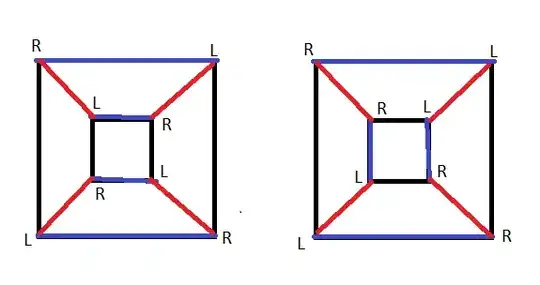Yes—you'll need an algorithm to compute it. Supposing your graph $G$ is connected, once you pick the color of one edge, the colors of all other edges are forced by the orientations of the vertices. Therefore, there are either exactly three ways to color the graph $G$ consistently (corresponding to cycling the colors $\text{red}\rightarrow\text{black}\rightarrow\text{blue}$) or it's altogether impossible.
Here's an algorithm to color your graph $G$. Make a new
directed graph $H$. $H$ has one node for every edge in the original graph $G$, and $H$ has a directed edge $a\rightarrow b$ to mean "$a$ and $b$ are clockwise neighboring edges around an R vertex, or counterclockwise neighbors around an $L$ vertex." In other words, $a\rightarrow b$ means "If $a$ is colored red, then $b$ must be colored black."
Note that you can tell the relationship between the colors of two edges $a$ and $b$ by computing the path length between $a$ and $b$ in $H$: edges with the same color are connected purely by paths that are multiples of 3 in length. Edges with red/black black/blue blue/red relationships are connected purely by paths of length $3k+1$. And edges with red/blue, black/red, blue/black relationships are connected purely by paths of length $3k+2$.
Moreover, because $G$ is cubic, whenever edges are connected by a path of length $p$, they are connected by another path of length $p+3$. And if edges are connected, we can be sure that they are connected by a path of length at most $E$ (the number of edges in the graph).
Thus the coloring procedure is: Given a connected graph $G$ with $E$ edges, build the directed graph $H$ as an adjacency matrix, and let $u$ be a vector with 1 in some position and zeroes everywhere else. ($u$ represents a node in $H$, i.e. an arbitrary edge in $G$). Compute $\mathsf{RED}=H^{E}u$. Every nonzero entry in $\mathsf{RED}$ is an edge that should be colored red. Similarly, nonzero entries in $\mathsf{BLACK}=H^{E+1}u$ should be colored black, and nonzero entries in $\mathsf{BLUE}=H^{E+2}u$ should be colored blue. The problem is solvable if and only if every edge appears in exactly one of these three lists.
